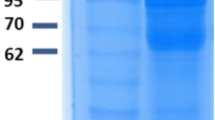Abstract
Insecticidal proteins produced by strains of Bacillus thuringenesis are specific toward target pests. One of the Bt proteins, Cry 1Ac has been used successfully for controlling crop predation by polyphagous pests Helicoverpa armigera. Structurally, Bt proteins consist of three domains; domain I and III are fairly homologous in various Bt proteins while domain II is hypervariable. The hypervariable domain II is believed to be responsible for specificity toward target pest. Successful deployment of Bt proteins requires knowledge of its specificity toward the insect. Various Bt proteins have been characterized for activity against coleopteran pests. Some Bt proteins of class Cry6 have been found to be active against potato weevil. We have evaluated the activity of Cry6B protein (BGSC-4D8) against lucerne weevil, Hypera postica, which is a major pest of forage crop Medicago sativa. Results revealed that the purified Cry6B protein is significantly active against the coleopteran pest with LC50 value 280 ng/μl. The leaves coated with the purified Cry6 toxin were three times less damaged as compared with the negative control.




Similar content being viewed by others
References
Beegle CC, Yamamoto T (1992) History of Bacillus thuringiensis Berliner research and development. Can Entomol 124:587–616
Bradford M (1976) A rapid and sensitive method for the quantitation of microgram quantities of protein utilizing the principle of protein-dye binding. Anal Biochem 72:248–254
Bravo A, Jansens S, Peferoen M (1992) Immunocytochemical localization of Bacillus thuringiensis insecticidal crystal proteins in intoxicated insects. J Invertebr Pathol 60:237–246
Chandra A, Pandey KC (2006) Resistance source for weevil (Hypera postica Gyll.) in genus Medicago. IGFRI Newsl. 12:7
Feitelson JS (1993) The Bacillus thuringiensis family tree. In: Kim L (ed) Advanced engineered pesticides. Marcel Dekker, Inc., New York, NY, pp 63–71
Feitelson JS, Payne J, Kim L (1992) Bacillus thuringiensis: insects and beyond. BioTech 10:271–275
Guo S, Liu M, Peng D et al (2008) New strategy for isolating novel nematicidal crystal protein genes from Bacillus thuringiensis strain YBT-1518. Appl Environ Microbiol 74:6997–7001
Jackson RE, Marcus MA, Gould F et al (2007) Cross-resistance responses of Cry1Ac-selected Heliothis virescens (Lepidoptera: Noctuidae) to the Bacillus thuringiensis protein Vip3A. J Econ Entomol 100:180–186
Mark T, Mark K, Guy C (1999) US Patent 5874288—Bacillus thuringiensis toxins with improved activity
Pandey KC, Hasan N, Bhaskar RB et al (1995) Losses-problem and present state of knowledge. In: Pests and diseases of major forage crops. All India Co-ordinated Research Project of Forage Crops, I.G.F.R.I., Jhansi, India, pp 2–3
Sambrook J, Fritsch EF, Maniatis T (1989) Molecular cloning: a laboratory manual, 2nd edn. Cold Spring Harbor Laboratory Press, New York, p 253
Schnepf E, Crickmore N, Van Rie J et al (1998) Bacillus thuringiensis and its pesticidal crystal proteins. Microbiol Mol Biol Rev 62:775–806
Schnepf EH, Schwab GE, Payne J et al. (1998) U.S. Patent 5,753,492—Genes encoding nematode-active toxins from Bacillus thuringiensis strains
Singh LN (1987) Fodder production strategies for temperate and sub-temperate regions of India. In: Singh P (ed) Forage production in India. Range Management Society of India. IGFRI, Jhansi, pp 21–27
Wei J-Z, Hale K, Carta L et al (2003) Bacillus thuringiensis crystal proteins that target nematodes. Proc Natl Acad Sci 100:2760–2765
Wu X, Leonard BR, Zhu YC et al (2009) Susceptibility of Cry1Ab-resistant and -susceptible sugarcane borer (Lepidoptera: Crambidae) to four Bacillus thuringiensis toxins. J Invertebr Pathol 100:29–34
Acknowledgments
Financial assistance from the Department of Biotechnology, Ministry of Science and Technology, Government of India, New Delhi, is gratefully acknowledged.
Author information
Authors and Affiliations
Corresponding author
Rights and permissions
About this article
Cite this article
Sharma, A., Kumar, S. & Bhatnagar, R.K. Bacillus thuringiensis Protein Cry6B (BGSC ID 4D8) is Toxic to Larvae of Hypera postica. Curr Microbiol 62, 597–605 (2011). https://doi.org/10.1007/s00284-010-9749-4
Received:
Accepted:
Published:
Issue Date:
DOI: https://doi.org/10.1007/s00284-010-9749-4




